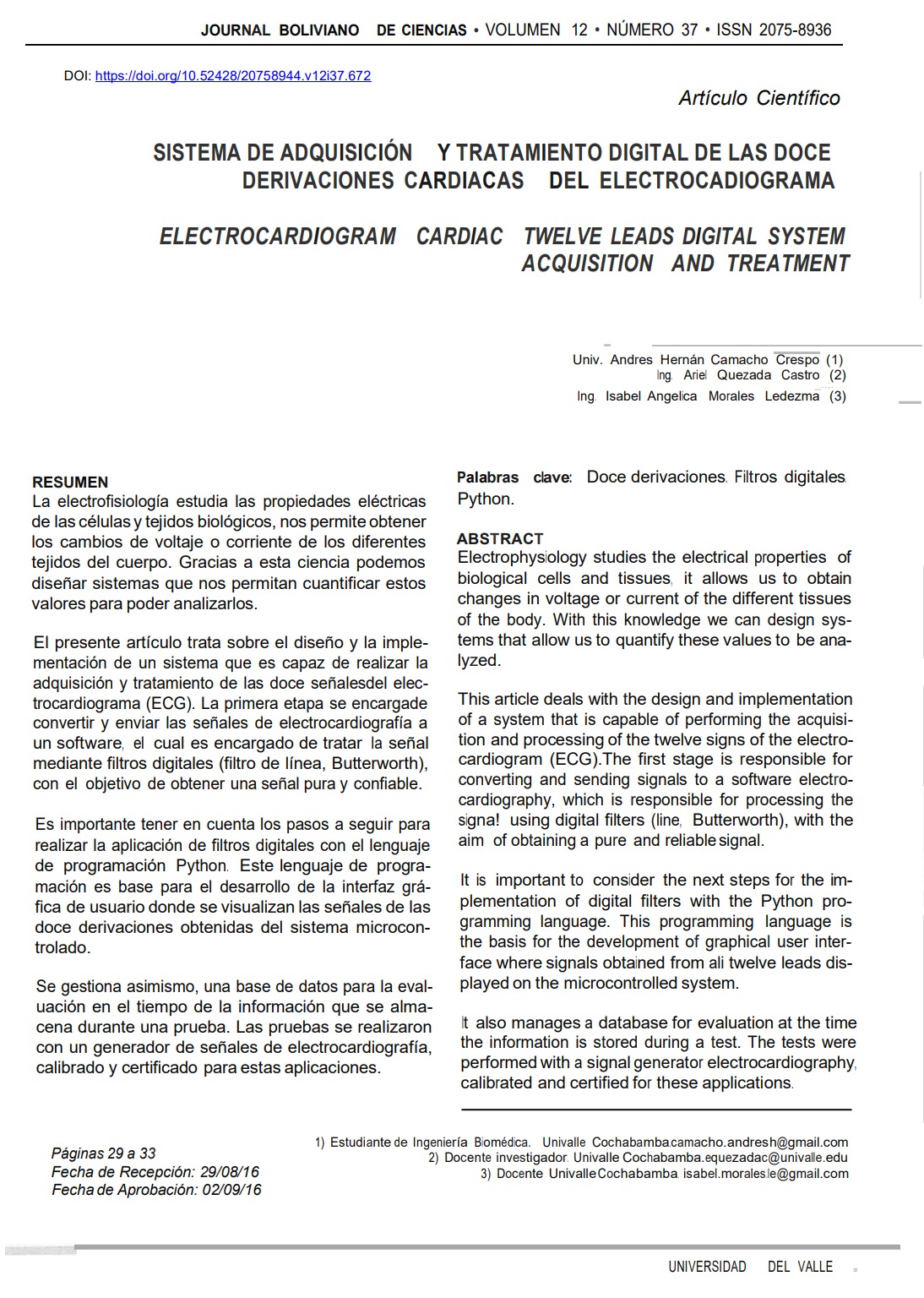Electrocardiogram Cardiac Twelve Leads Digital System Acquisition and Treatment
DOI:
https://doi.org/10.52428/20758944.v12i37.672Keywords:
Twelve leads, Digital filters, PythonAbstract
Electrophysiology studies the electrical properties of biological cells and tissues, it allows us to obtain changes in voltage or current of the different tissues of the body. With this knowledge we can design systems that allow us to quantify these values to be analyzed. This article deals with the design and implementation of a system that is capable of performing the acquisition and processing of the twelve signs of the electrocardiogram (ECG). The first stage is responsible for converting and sending signals to a software electrocardiography, which is responsible for processing the signal using digital filters (line, Butterworth), with the aim of obtaining a pure and reliable signal.
lt is important to consider the next steps for the implementation of digital filters with the Python programming language. This programming language is the basis for the development of graphical user interface where signals obtained from ali twelve leads displayed on the microcontrolled system. lt also manages a database for evaluation at the time the information is stored during a test. The tests were performed with a signal generator electrocardiography, calibrated and certified for these applications.
Downloads
References
(1) ARTHUR C. GUYTON, M. -J. (1997). Tratado de fisiología medica. Mexico: lnteramericana McGRAWHILL.
(2) PRESEDO, J. M. (n.d.). Retrieved from http://www.usc.es/catedras/telemedicina/2005/materia1Asig natura/AdquisicionSenalesBiolog icas. pdf (Fecha y hora de consulta: 25/10/15 20:35). https://doi.org/10.14409/natura.v1i20.3572
(3) ANALOG DEVICES - low cost power instrumentation amplifier AD620 http://www.analog.com/media/en/technical-documentation/data-sheets/AD620.pdf (Fecha y hora de consulta: 25/10/15 20:35).
(4) NXP SEMICONDUCTORS- 74HC4051; 74HCT4051 http://www.nxp.com/documents/data_sheet/74HC_ HCT4051.pdf (Fecha y hora de consulta: 25/10/15 20:35).
(5) ARDUINO. (n.d.). Retrieved from www.arduino.cc (Fecha y hora de consulta: 25/10/15 20:35).
(6) PYTHON. (n.d.). Retrieved from www.python.org (Fecha y hora de consulta: 25/10/15 20:35).

Downloads
Published
How to Cite
Issue
Section
License
Copyright (c) 2016 Andrés Hernán Camacho Crespo, Ariel Quezada Castr e Isabel Angélica Morales Ledezma

This work is licensed under a Creative Commons Attribution 4.0 International License.
Authors who publish with this journal agree to the following terms:
- Authors retain copyright and grant the journal right of first publication with the work simultaneously licensed under a Creative Commons Attribution License 4.0 that allows others to share the work with an acknowledgement of the work's authorship and initial publication in this journal.
- Authors are able to enter into separate, additional contractual arrangements for the non-exclusive distribution of the journal's published version of the work (e.g., post it to an institutional repository or publish it in a book), with an acknowledgement of its initial publication in this journal.
- Authors are permitted and encouraged to post their work online (e.g., in institutional repositories or on their website) prior to and during the submission process, as it can lead to productive exchanges, as well as earlier and greater citation of published work.














